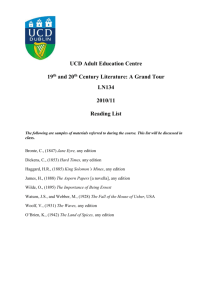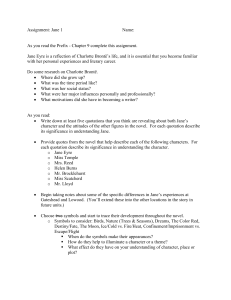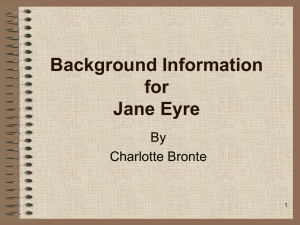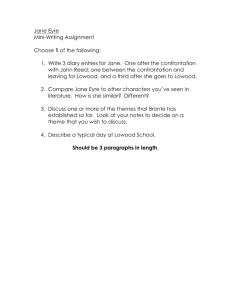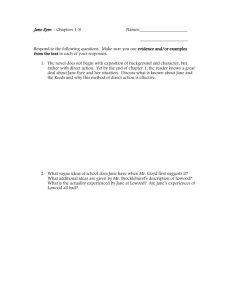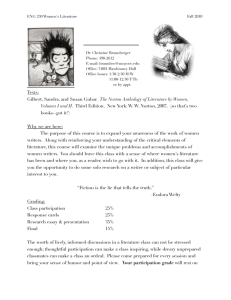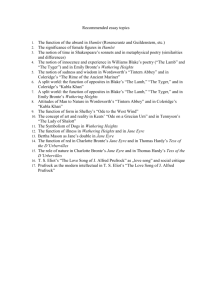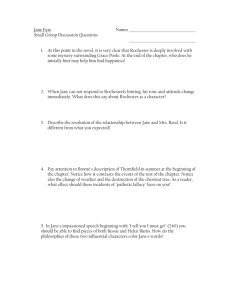AP English Language and Composition Jane Eyre Summer
advertisement
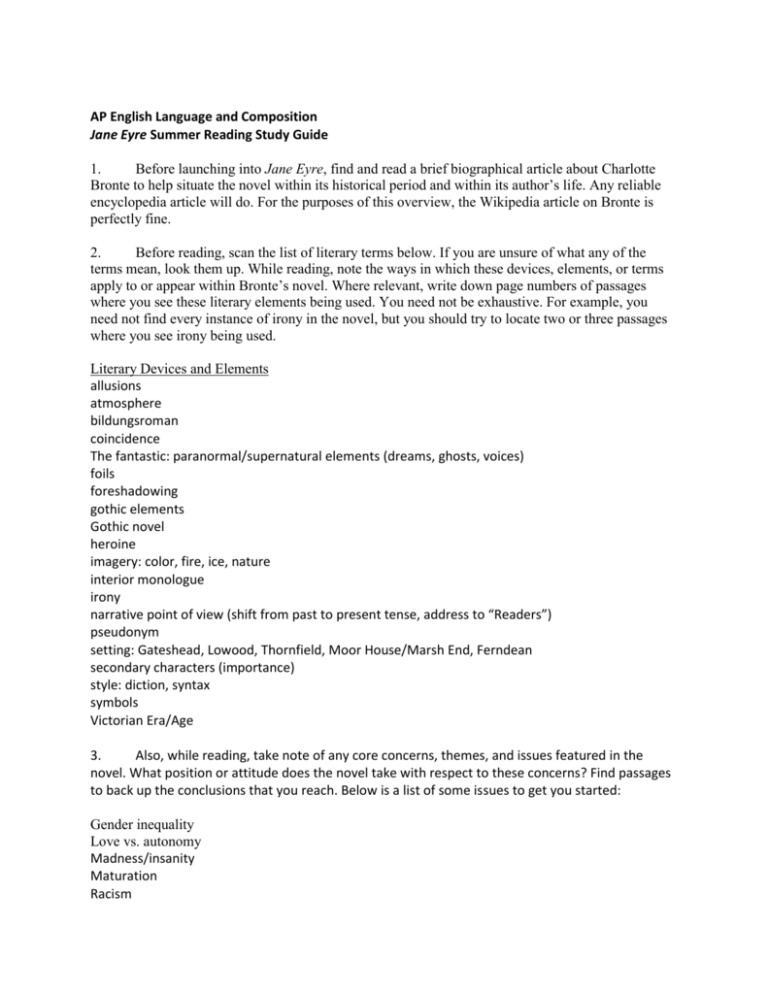
AP English Language and Composition Jane Eyre Summer Reading Study Guide 1. Before launching into Jane Eyre, find and read a brief biographical article about Charlotte Bronte to help situate the novel within its historical period and within its author’s life. Any reliable encyclopedia article will do. For the purposes of this overview, the Wikipedia article on Bronte is perfectly fine. 2. Before reading, scan the list of literary terms below. If you are unsure of what any of the terms mean, look them up. While reading, note the ways in which these devices, elements, or terms apply to or appear within Bronte’s novel. Where relevant, write down page numbers of passages where you see these literary elements being used. You need not be exhaustive. For example, you need not find every instance of irony in the novel, but you should try to locate two or three passages where you see irony being used. Literary Devices and Elements allusions atmosphere bildungsroman coincidence The fantastic: paranormal/supernatural elements (dreams, ghosts, voices) foils foreshadowing gothic elements Gothic novel heroine imagery: color, fire, ice, nature interior monologue irony narrative point of view (shift from past to present tense, address to “Readers”) pseudonym setting: Gateshead, Lowood, Thornfield, Moor House/Marsh End, Ferndean secondary characters (importance) style: diction, syntax symbols Victorian Era/Age 3. Also, while reading, take note of any core concerns, themes, and issues featured in the novel. What position or attitude does the novel take with respect to these concerns? Find passages to back up the conclusions that you reach. Below is a list of some issues to get you started: Gender inequality Love vs. autonomy Madness/insanity Maturation Racism Social class system Spirituality/religious faith Women’s position in society 4. Finally, after reading Jane Eyre, review the three excerpts below. Which one seems to be the most relevant, insightful, or illuminating with respect to Bronte’s novel? Why? About Jane Eyre: The Critics From British Women Fiction Writers of the 19 Century, ed. Harold Bloom (Philadelphia: Chelsea House Publishers, 1998). th 19 century: Elizabeth Rigby th Still we say again this is a very remarkable book. We are painfully alive to the moral, religious, and literary deficiencies of the picture, and such passages of beauty and power as we have quoted cannot redeem it, but it is impossible not to be spellbound with the freedom of the touch. It would be mere hackneyed courtesy to call it “fine writing.” It bears no impress of being written at all, but is poured out rather in the heat and hurry of instinct, which flows ungovernably on to its object, indifferent by what means it reaches it,, and unconscious too. As regards the author’s chief object, however, it is a failure – that, namely, of making a plain, odd woman, destitute of all the conventional features of feminine attraction, interesting in our sight. We deny that he has succeeded in this. Jane Eyre, in spite of some grand things about her, is a being totally uncongenial to our feelings from beginning to end. We acknowledge her firmness – we respect her determination – we feel for her struggles; but, for all that, and setting aside higher considerations, the impression she leaves on our mind is that of a decidedly vulgar-minded woman – one whom we should not care for as an acquaintance, whom we should not seek as a friend, whom we should not desire for a relation, and who we should scrupulously avoid for a governess. Elizabeth Rigby [review of Jane Eyre], Quarterly Review, no. 167, December 1848, 172-174. 20 Century: Rosemarie Bodenheimer th On the first page of the Jane Eyre, Jane is ordered to keep silent; at the end of the novel her voice becomes the central source of perception for her blind and captive audience, Mr. Rochester, “impressing by sound on his ear what light could no longer stamp on his eye.” How Jane acquires and uses the power of speech, and with whom, are subjects that bear both upon the story of her development as a character and upon the first-person narrative stance that Charlotte Bronte invented for her first successful novel. At many points in the telling, Jane’s story calls attention to the questions, “How shall I learn to tell the story of my life?” and “What kind of story is it?” Rosemarie Bodenheimer, “Jane Eyre is Search of Her story,” Papers on Language and Literature 16, no. 3 (Summer 1980), reprinted in The Brontes, ed. Harold Bloom (New York: Chelsea House Publishers, 1987), 155-156, 161. 20 century: Virginia Woolf th A novelist, we reflect, is bound to build up his structure with much very perishable material which begins by lending it reality and ends by cumbering it with rubbish. As we open Jane Eyre once more we cannot stifle the suspicion that we shall find her world of imagination as antiquated, midVictorian, and out of date as the parsonage on the moor, a place only to be visited by the curious, only preserved by the pious. So we open Jane Eyre, and in two pages every doubt is swept clean from our minds: “Folds of scarlet drapery shut my view to the right hand; to the left were clear panes of glass, protecting, but not separating me from the drear November day. At intervals, while turning over the leaves of my book, I studied the aspect of that winter afternoon. Afar, it offered a pale blank of mist and cloud; near, a scene of wet lawn and storm-beat shrub, with ceaseless rain sweeping away wildly before a long and lamentable blast.” There is nothing more perishable than the moor itself, or more subject to the sway of fashion than the “long and lamentable blast.” Nor is this exhilaration short-lived. It rushes us through the entire volume, without gives us time to think, without letting us lift our eyes from the page. So intense is our absorption that if someone moves in the room the movement seems to take place not there but up in Yorkshire. . . Charlotte Bronte, at least, owed nothing to the reading of many books. She never learned the smoothness of the professional writer, or acquired his ability to stuff and sway his language as he chooses. . . she writes, as any leader-writer in a provincial journal might have written; but gathering fire and speed goes on in her own authentic voice ‘till I had passed the outworks of conventional reserve and crossed the threshold of confidence, and won a place by this hearts’ very hearthstone. It is there that she takes her seat; it is the red and fitful glow of the heart’s fire which illumines her page. In other words, we read Charlotte Bronte not for the exquisite observation of character. . . but for her poetry. . . she calls in nature to describe a state of mind which could not otherwise be expressed. . . They [Emily and Charlotte Bronte] seized those aspects of earth which were most akin to what they themselves felt or imputed to their characters, and so their storms, their moors, their lovely spaces of summer weather are not ornaments to decorate a dull page or display a writer’s powers of observation – they carry on the emotion and light up the meaning of the book. Virginia Woolf, “Jane Eyre and Wuthering Heights” (1916), Collected Essays, ed. Leonard Woolf, Vol. 1 (1967), excerpted in The Critical Perspective, Vol. 7, ed. Harold Bloom (New York: Chelsea House Publishers, 1988), 4194-95.
